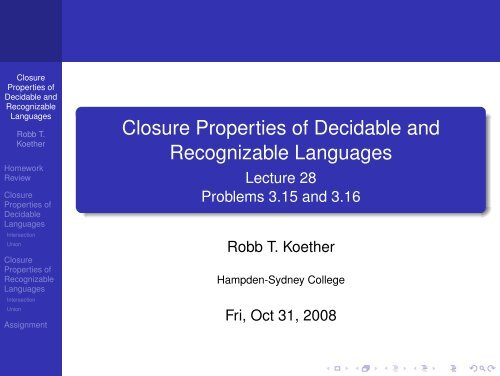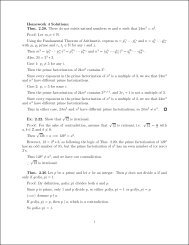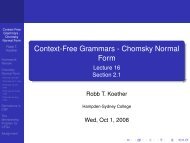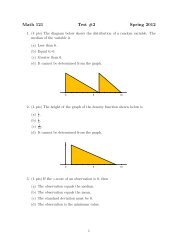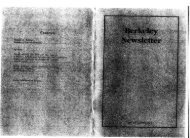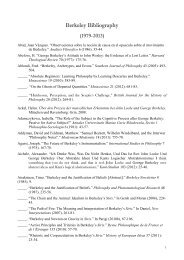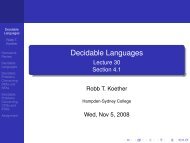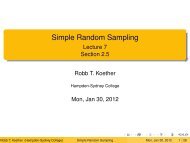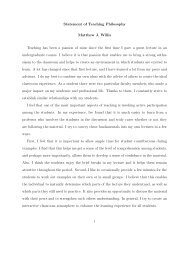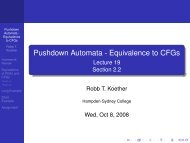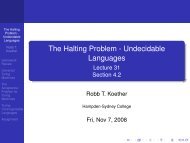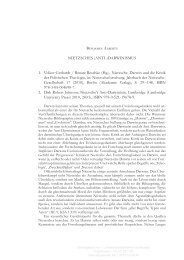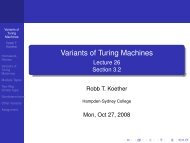Closure Properties of Decidable and Recognizable Languages ...
Closure Properties of Decidable and Recognizable Languages ...
Closure Properties of Decidable and Recognizable Languages ...
Create successful ePaper yourself
Turn your PDF publications into a flip-book with our unique Google optimized e-Paper software.
<strong>Closure</strong><br />
<strong>Properties</strong> <strong>of</strong><br />
<strong>Decidable</strong> <strong>and</strong><br />
<strong>Recognizable</strong><br />
<strong>Languages</strong><br />
Robb T.<br />
Koether<br />
Homework<br />
Review<br />
<strong>Closure</strong><br />
<strong>Properties</strong> <strong>of</strong><br />
<strong>Decidable</strong><br />
<strong>Languages</strong><br />
Intersection<br />
Union<br />
<strong>Closure</strong><br />
<strong>Properties</strong> <strong>of</strong><br />
<strong>Recognizable</strong><br />
<strong>Languages</strong><br />
Intersection<br />
Union<br />
Assignment<br />
<strong>Closure</strong> <strong>Properties</strong> <strong>of</strong> <strong>Decidable</strong> <strong>and</strong><br />
<strong>Recognizable</strong> <strong>Languages</strong><br />
Lecture 28<br />
Problems 3.15 <strong>and</strong> 3.16<br />
Robb T. Koether<br />
Hampden-Sydney College<br />
Fri, Oct 31, 2008
Outline<br />
<strong>Closure</strong><br />
<strong>Properties</strong> <strong>of</strong><br />
<strong>Decidable</strong> <strong>and</strong><br />
<strong>Recognizable</strong><br />
<strong>Languages</strong><br />
Robb T.<br />
Koether<br />
Homework<br />
Review<br />
<strong>Closure</strong><br />
<strong>Properties</strong> <strong>of</strong><br />
<strong>Decidable</strong><br />
<strong>Languages</strong><br />
Intersection<br />
Union<br />
<strong>Closure</strong><br />
<strong>Properties</strong> <strong>of</strong><br />
<strong>Recognizable</strong><br />
<strong>Languages</strong><br />
Intersection<br />
Union<br />
Assignment<br />
1 Homework Review<br />
2 <strong>Closure</strong> <strong>Properties</strong> <strong>of</strong> <strong>Decidable</strong> <strong>Languages</strong><br />
Intersection<br />
Union<br />
3 <strong>Closure</strong> <strong>Properties</strong> <strong>of</strong> <strong>Recognizable</strong> <strong>Languages</strong><br />
Intersection<br />
Union<br />
4 Assignment
Homework Review<br />
<strong>Closure</strong><br />
<strong>Properties</strong> <strong>of</strong><br />
<strong>Decidable</strong> <strong>and</strong><br />
<strong>Recognizable</strong><br />
<strong>Languages</strong><br />
Robb T.<br />
Koether<br />
Homework<br />
Review<br />
<strong>Closure</strong><br />
<strong>Properties</strong> <strong>of</strong><br />
<strong>Decidable</strong><br />
<strong>Languages</strong><br />
Intersection<br />
Union<br />
<strong>Closure</strong><br />
<strong>Properties</strong> <strong>of</strong><br />
<strong>Recognizable</strong><br />
<strong>Languages</strong><br />
Intersection<br />
Union<br />
Exercise 3.6, page 160.<br />
In Theorem 3.21 we showed that a language is<br />
Turing-recognizable iff some enumerator enumerates it.<br />
Why didn’t we use the following simpler algorithm for the<br />
forward direction <strong>of</strong> the pro<strong>of</strong>? As before, s 1 , s 2 , . . . is a list <strong>of</strong><br />
all strings in Σ ∗ .<br />
E = “Ignore the input.<br />
1 Repeat the following for i = 1, 2, 3, . . .<br />
2 Run M on s i .<br />
3 If it accepts, print out s i .”<br />
Assignment
Homework Review<br />
<strong>Closure</strong><br />
<strong>Properties</strong> <strong>of</strong><br />
<strong>Decidable</strong> <strong>and</strong><br />
<strong>Recognizable</strong><br />
<strong>Languages</strong><br />
Robb T.<br />
Koether<br />
Homework<br />
Review<br />
<strong>Closure</strong><br />
<strong>Properties</strong> <strong>of</strong><br />
<strong>Decidable</strong><br />
<strong>Languages</strong><br />
Intersection<br />
Union<br />
<strong>Closure</strong><br />
<strong>Properties</strong> <strong>of</strong><br />
<strong>Recognizable</strong><br />
<strong>Languages</strong><br />
Intersection<br />
Union<br />
Exercise 3.7, page 160.<br />
Explain why the following is not a description <strong>of</strong> a legitimate<br />
Turing machine.<br />
M bad = “The input is a polynomial p over variables x 1 , . . . , x n .<br />
1 Try all possible settings <strong>of</strong> x 1 , . . . , x n to integer values.<br />
2 Evaluate p on all <strong>of</strong> these settings.<br />
3 If any <strong>of</strong> these settings evaluates to 0, accept;<br />
otherwise, reject.”<br />
Assignment
<strong>Closure</strong> <strong>Properties</strong> <strong>of</strong> <strong>Decidable</strong> <strong>Languages</strong><br />
<strong>Closure</strong><br />
<strong>Properties</strong> <strong>of</strong><br />
<strong>Decidable</strong> <strong>and</strong><br />
<strong>Recognizable</strong><br />
<strong>Languages</strong><br />
Robb T.<br />
Koether<br />
Homework<br />
Review<br />
<strong>Closure</strong><br />
<strong>Properties</strong> <strong>of</strong><br />
<strong>Decidable</strong><br />
<strong>Languages</strong><br />
Intersection<br />
Union<br />
<strong>Closure</strong><br />
<strong>Properties</strong> <strong>of</strong><br />
<strong>Recognizable</strong><br />
<strong>Languages</strong><br />
Intersection<br />
Union<br />
Theorem (<strong>Closure</strong> <strong>Properties</strong> <strong>of</strong> <strong>Decidable</strong> <strong>Languages</strong>)<br />
The class <strong>of</strong> decidable languages is closed under<br />
Union<br />
Intersection<br />
Complementation<br />
Concatenation<br />
Star<br />
Assignment
<strong>Closure</strong> Under Intersection<br />
<strong>Closure</strong><br />
<strong>Properties</strong> <strong>of</strong><br />
<strong>Decidable</strong> <strong>and</strong><br />
<strong>Recognizable</strong><br />
<strong>Languages</strong><br />
Robb T.<br />
Koether<br />
Homework<br />
Review<br />
<strong>Closure</strong><br />
<strong>Properties</strong> <strong>of</strong><br />
<strong>Decidable</strong><br />
<strong>Languages</strong><br />
Intersection<br />
Union<br />
Theorem<br />
If L 1 <strong>and</strong> L 2 are decidable, then L 1 ∩ L 2 is decidable.<br />
<strong>Closure</strong><br />
<strong>Properties</strong> <strong>of</strong><br />
<strong>Recognizable</strong><br />
<strong>Languages</strong><br />
Intersection<br />
Union<br />
Assignment
<strong>Closure</strong> <strong>of</strong> Intersection<br />
<strong>Closure</strong><br />
<strong>Properties</strong> <strong>of</strong><br />
<strong>Decidable</strong> <strong>and</strong><br />
<strong>Recognizable</strong><br />
<strong>Languages</strong><br />
Robb T.<br />
Koether<br />
Homework<br />
Review<br />
Pro<strong>of</strong>.<br />
Let D 1 be a decider for L 1 <strong>and</strong> let D 2 be a decider for L 2 .<br />
Then build a decider D for L 1 ∩ L 2 as in the following<br />
diagram.<br />
<strong>Closure</strong><br />
<strong>Properties</strong> <strong>of</strong><br />
<strong>Decidable</strong><br />
<strong>Languages</strong><br />
Intersection<br />
w<br />
D<br />
yes<br />
yes<br />
D 1 D 2<br />
yes<br />
Union<br />
<strong>Closure</strong><br />
<strong>Properties</strong> <strong>of</strong><br />
<strong>Recognizable</strong><br />
<strong>Languages</strong><br />
no<br />
no<br />
no<br />
Intersection<br />
Union<br />
Assignment
<strong>Closure</strong> Under Union<br />
<strong>Closure</strong><br />
<strong>Properties</strong> <strong>of</strong><br />
<strong>Decidable</strong> <strong>and</strong><br />
<strong>Recognizable</strong><br />
<strong>Languages</strong><br />
Robb T.<br />
Koether<br />
Homework<br />
Review<br />
<strong>Closure</strong><br />
<strong>Properties</strong> <strong>of</strong><br />
<strong>Decidable</strong><br />
<strong>Languages</strong><br />
Intersection<br />
Union<br />
Theorem<br />
If L 1 <strong>and</strong> L 2 are decidable, then L 1 ∪ L 2 is decidable.<br />
<strong>Closure</strong><br />
<strong>Properties</strong> <strong>of</strong><br />
<strong>Recognizable</strong><br />
<strong>Languages</strong><br />
Intersection<br />
Union<br />
Assignment
<strong>Closure</strong> Under Union<br />
<strong>Closure</strong><br />
<strong>Properties</strong> <strong>of</strong><br />
<strong>Decidable</strong> <strong>and</strong><br />
<strong>Recognizable</strong><br />
<strong>Languages</strong><br />
Robb T.<br />
Koether<br />
Homework<br />
Review<br />
Pro<strong>of</strong>.<br />
Let D 1 be a decider for L 1 <strong>and</strong> let D 2 be a decider for L 2 .<br />
Then build a decider D for L 1 ∪ L 2 as in the following<br />
diagram.<br />
<strong>Closure</strong><br />
<strong>Properties</strong> <strong>of</strong><br />
<strong>Decidable</strong><br />
<strong>Languages</strong><br />
Intersection<br />
w<br />
D<br />
no<br />
no<br />
D 1 D 2<br />
no<br />
Union<br />
<strong>Closure</strong><br />
<strong>Properties</strong> <strong>of</strong><br />
<strong>Recognizable</strong><br />
<strong>Languages</strong><br />
yes<br />
yes<br />
yes<br />
Intersection<br />
Union<br />
Assignment
<strong>Closure</strong> Under Other Operators<br />
<strong>Closure</strong><br />
<strong>Properties</strong> <strong>of</strong><br />
<strong>Decidable</strong> <strong>and</strong><br />
<strong>Recognizable</strong><br />
<strong>Languages</strong><br />
Robb T.<br />
Koether<br />
Homework<br />
Review<br />
<strong>Closure</strong><br />
<strong>Properties</strong> <strong>of</strong><br />
<strong>Decidable</strong><br />
<strong>Languages</strong><br />
Intersection<br />
Union<br />
How would we show that if L 1 <strong>and</strong> L 2 are decidable,<br />
then so are<br />
L 1 L 2<br />
L 1<br />
L ∗ 1<br />
<strong>Closure</strong><br />
<strong>Properties</strong> <strong>of</strong><br />
<strong>Recognizable</strong><br />
<strong>Languages</strong><br />
Intersection<br />
Union<br />
Assignment
<strong>Closure</strong> <strong>Properties</strong> <strong>of</strong> <strong>Recognizable</strong> <strong>Languages</strong><br />
<strong>Closure</strong><br />
<strong>Properties</strong> <strong>of</strong><br />
<strong>Decidable</strong> <strong>and</strong><br />
<strong>Recognizable</strong><br />
<strong>Languages</strong><br />
Robb T.<br />
Koether<br />
Homework<br />
Review<br />
<strong>Closure</strong><br />
<strong>Properties</strong> <strong>of</strong><br />
<strong>Decidable</strong><br />
<strong>Languages</strong><br />
Intersection<br />
Union<br />
<strong>Closure</strong><br />
<strong>Properties</strong> <strong>of</strong><br />
<strong>Recognizable</strong><br />
<strong>Languages</strong><br />
Intersection<br />
Union<br />
Theorem (<strong>Closure</strong> <strong>Properties</strong> <strong>of</strong> <strong>Recognizable</strong> <strong>Languages</strong>)<br />
The class <strong>of</strong> recognizable languages is closed under<br />
Union<br />
Intersection<br />
Concatenation<br />
Star<br />
Assignment
<strong>Closure</strong> Under Intersection<br />
<strong>Closure</strong><br />
<strong>Properties</strong> <strong>of</strong><br />
<strong>Decidable</strong> <strong>and</strong><br />
<strong>Recognizable</strong><br />
<strong>Languages</strong><br />
Robb T.<br />
Koether<br />
Homework<br />
Review<br />
<strong>Closure</strong><br />
<strong>Properties</strong> <strong>of</strong><br />
<strong>Decidable</strong><br />
<strong>Languages</strong><br />
Intersection<br />
Union<br />
Theorem<br />
If L 1 <strong>and</strong> L 2 are recognizable, then L 1 ∩ L 2 is recognizable.<br />
<strong>Closure</strong><br />
<strong>Properties</strong> <strong>of</strong><br />
<strong>Recognizable</strong><br />
<strong>Languages</strong><br />
Intersection<br />
Union<br />
Assignment
<strong>Closure</strong> Under Intersection<br />
<strong>Closure</strong><br />
<strong>Properties</strong> <strong>of</strong><br />
<strong>Decidable</strong> <strong>and</strong><br />
<strong>Recognizable</strong><br />
<strong>Languages</strong><br />
Robb T.<br />
Koether<br />
Homework<br />
Review<br />
<strong>Closure</strong><br />
<strong>Properties</strong> <strong>of</strong><br />
<strong>Decidable</strong><br />
<strong>Languages</strong><br />
Intersection<br />
Union<br />
<strong>Closure</strong><br />
<strong>Properties</strong> <strong>of</strong><br />
<strong>Recognizable</strong><br />
<strong>Languages</strong><br />
Intersection<br />
Union<br />
Pro<strong>of</strong>.<br />
Let R 1 be a recognizer for L 1 <strong>and</strong> let R 2 be a recognizer<br />
for L 2 .<br />
Then build a recognizer R for L 1 ∩ L 2 as in the following<br />
diagram.<br />
w<br />
R<br />
yes<br />
yes<br />
R 1 R 2<br />
yes<br />
Assignment
<strong>Closure</strong> Under Union<br />
<strong>Closure</strong><br />
<strong>Properties</strong> <strong>of</strong><br />
<strong>Decidable</strong> <strong>and</strong><br />
<strong>Recognizable</strong><br />
<strong>Languages</strong><br />
Robb T.<br />
Koether<br />
Homework<br />
Review<br />
<strong>Closure</strong><br />
<strong>Properties</strong> <strong>of</strong><br />
<strong>Decidable</strong><br />
<strong>Languages</strong><br />
Intersection<br />
Union<br />
Theorem<br />
If L 1 <strong>and</strong> L 2 are recognizable, then L 1 ∪ L 2 is recognizable.<br />
<strong>Closure</strong><br />
<strong>Properties</strong> <strong>of</strong><br />
<strong>Recognizable</strong><br />
<strong>Languages</strong><br />
Intersection<br />
Union<br />
Assignment
<strong>Closure</strong> Under Union<br />
<strong>Closure</strong><br />
<strong>Properties</strong> <strong>of</strong><br />
<strong>Decidable</strong> <strong>and</strong><br />
<strong>Recognizable</strong><br />
<strong>Languages</strong><br />
Robb T.<br />
Koether<br />
Homework<br />
Review<br />
Pro<strong>of</strong>.<br />
Let R 1 be a recognizer for L 1 <strong>and</strong> let R 2 be a recognizer<br />
for L 2 .<br />
Then build a recognizer R for L 1 ∪ L 2 as in the following<br />
diagram.<br />
<strong>Closure</strong><br />
<strong>Properties</strong> <strong>of</strong><br />
<strong>Decidable</strong><br />
<strong>Languages</strong><br />
Intersection<br />
R<br />
R 1<br />
yes<br />
Union<br />
<strong>Closure</strong><br />
<strong>Properties</strong> <strong>of</strong><br />
<strong>Recognizable</strong><br />
<strong>Languages</strong><br />
Intersection<br />
w<br />
R 2<br />
yes<br />
yes<br />
Union<br />
Assignment
<strong>Closure</strong> <strong>of</strong> Union<br />
<strong>Closure</strong><br />
<strong>Properties</strong> <strong>of</strong><br />
<strong>Decidable</strong> <strong>and</strong><br />
<strong>Recognizable</strong><br />
<strong>Languages</strong><br />
Robb T.<br />
Koether<br />
Homework<br />
Review<br />
<strong>Closure</strong><br />
<strong>Properties</strong> <strong>of</strong><br />
<strong>Decidable</strong><br />
<strong>Languages</strong><br />
Intersection<br />
Union<br />
Pro<strong>of</strong>.<br />
In that diagram, we must be careful to alternate<br />
execution between R 1 <strong>and</strong> R 2 .<br />
<strong>Closure</strong><br />
<strong>Properties</strong> <strong>of</strong><br />
<strong>Recognizable</strong><br />
<strong>Languages</strong><br />
Intersection<br />
Union<br />
Assignment
<strong>Closure</strong> Under Other Operators<br />
<strong>Closure</strong><br />
<strong>Properties</strong> <strong>of</strong><br />
<strong>Decidable</strong> <strong>and</strong><br />
<strong>Recognizable</strong><br />
<strong>Languages</strong><br />
Robb T.<br />
Koether<br />
Homework<br />
Review<br />
<strong>Closure</strong><br />
<strong>Properties</strong> <strong>of</strong><br />
<strong>Decidable</strong><br />
<strong>Languages</strong><br />
Intersection<br />
Union<br />
How would we show that if L 1 <strong>and</strong> L 2 are recognizable,<br />
then so are<br />
L 1 L 2<br />
L ∗ 1<br />
Why is L 1 not necessarily recognizable?<br />
<strong>Closure</strong><br />
<strong>Properties</strong> <strong>of</strong><br />
<strong>Recognizable</strong><br />
<strong>Languages</strong><br />
Intersection<br />
Union<br />
Assignment
Assignment<br />
<strong>Closure</strong><br />
<strong>Properties</strong> <strong>of</strong><br />
<strong>Decidable</strong> <strong>and</strong><br />
<strong>Recognizable</strong><br />
<strong>Languages</strong><br />
Robb T.<br />
Koether<br />
Homework<br />
Review<br />
<strong>Closure</strong><br />
<strong>Properties</strong> <strong>of</strong><br />
<strong>Decidable</strong><br />
<strong>Languages</strong><br />
Intersection<br />
Union<br />
Homework<br />
Read Section 3.2, pages 152 - 154.<br />
Problems 15, 16, page 161.<br />
<strong>Closure</strong><br />
<strong>Properties</strong> <strong>of</strong><br />
<strong>Recognizable</strong><br />
<strong>Languages</strong><br />
Intersection<br />
Union<br />
Assignment


